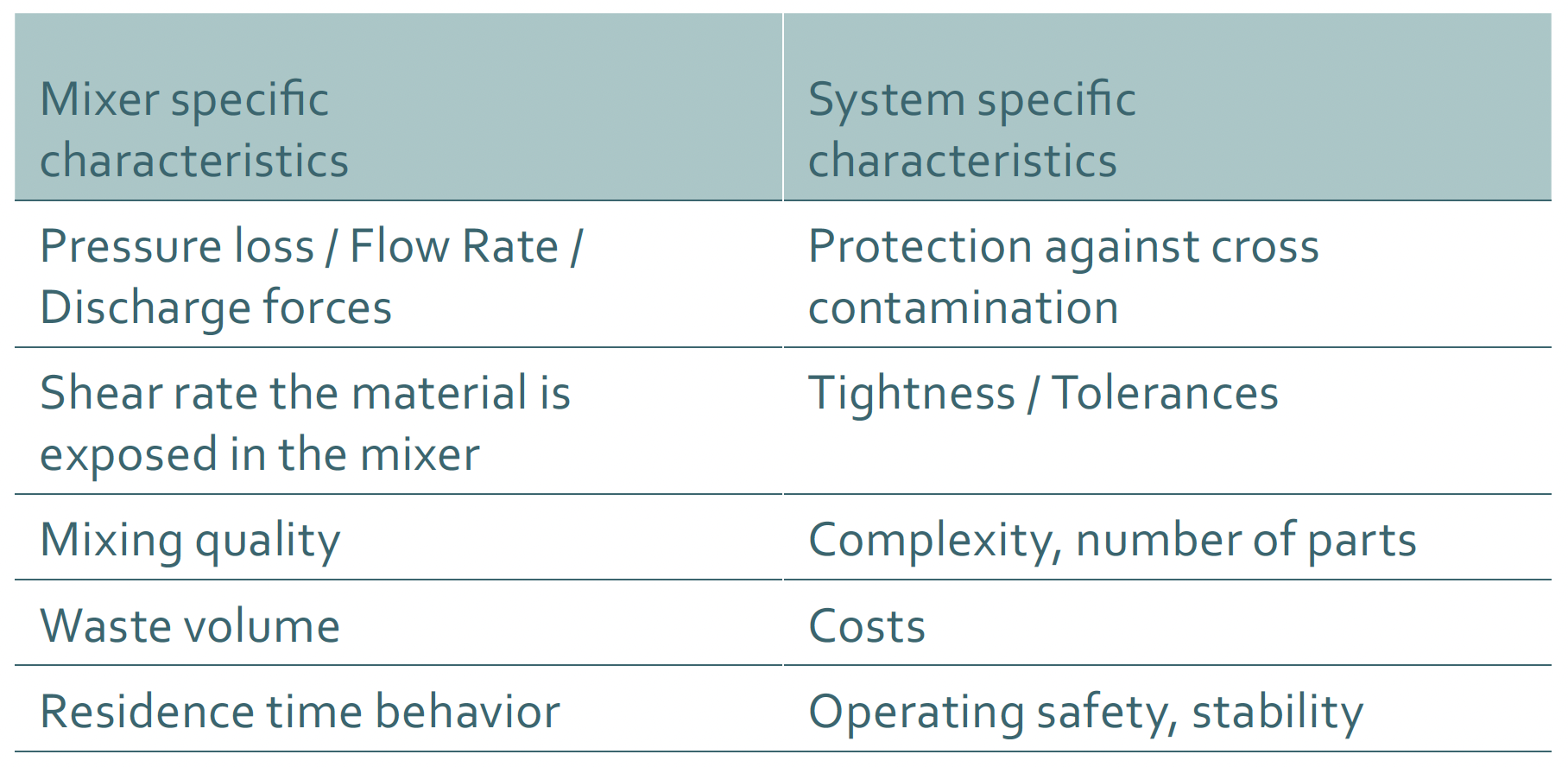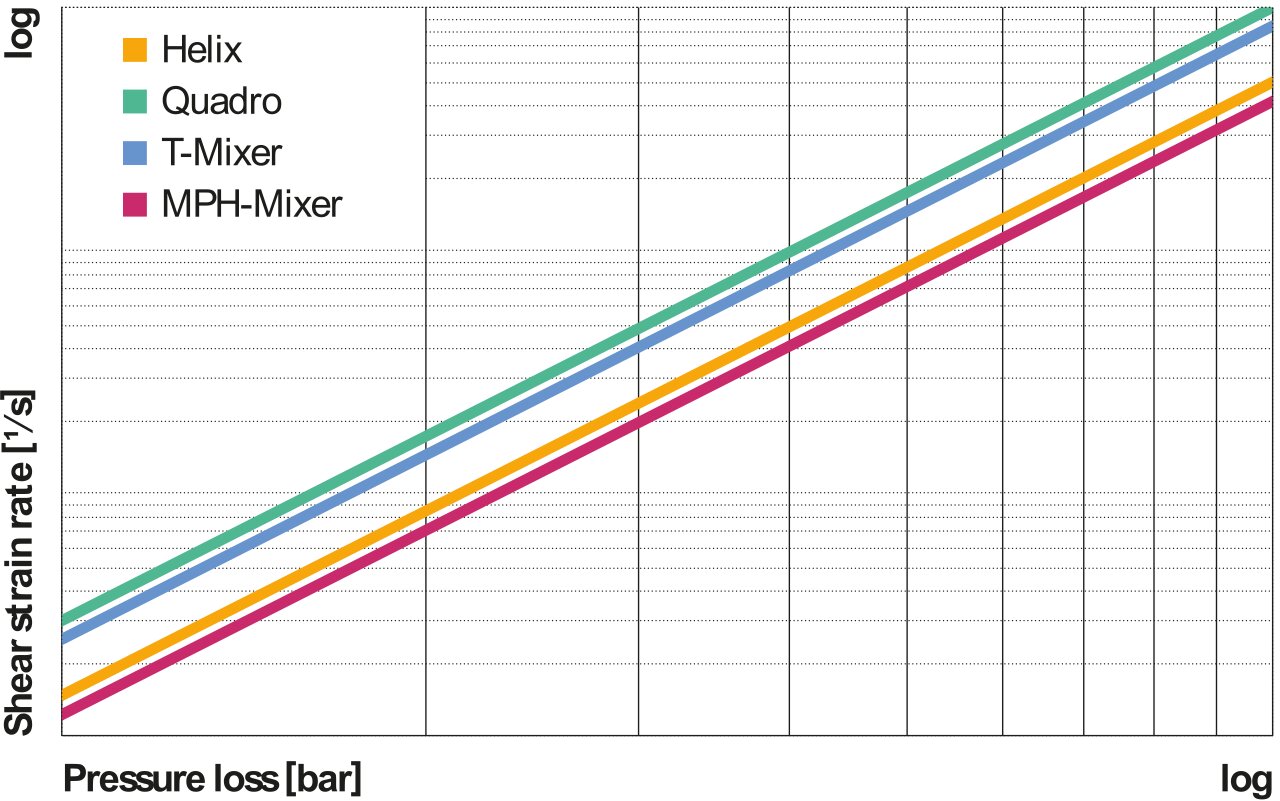Parameters to quantify mixing efficiency of static mixers
MIXING TECHNOLOGY AT MEDMIX AG – Depending on the material to mix and the pre-defined application, different mixer characteristics are of particular importance. This chapter focuses on characteristics which describe the properties of the mixer itself (mixer specific characteristics) rather than the application system as a whole (system specific characteristics).
 Table 1 - Categorization of characteristics
Table 1 - Categorization of characteristics
The mixing efficiency of a mixer can be characterized by the pressure drop over the mixer length, by the shear rate to which the material is exposed to in the mixer, by the mixing quality, by the volume of material remaining in the mixer and by its residence time behavior (see Table 1). In order to obtain a quantitative and comparable description of these properties, dimensionless characteristics were defined. This makes it possible to evaluate the mixing efficiency independently of the material properties of the components to be mixed and the operating conditions
1.1. Parameters to assess the efficiency of a mixer
1.1.1. Mixing quality
Due to the high viscosity of the two components, 2C materials for industrial and dental applications almost always have a laminar flow. As a result, mixing does not occur by turbulence, but can only be achieved by repeatedly separating, shearing and recombining the components to be mixed. The mixing quality is often expressed in terms of the COV (Coefficient of Variation), which is a purely stochastic variable and is defined as the standard deviation of the concentration distribution divided by its mean value. Therefore, the lower the CoV value, the better the quality of the mixture. In the case of laminar flow, the CoV that can be achieved by a given mixer depends only on the rheology of the material being mixed, the type of mixer and the number of mixing elements, but is independent of the operating conditions.
1.1.2. Pressure loss
The pressure loss in the mixer - or from the user’s point of view, the force required to discharge the material - is a key characteristic since this force must be applied by a user or a discharge device. If the discharge force is already specified (for example by a pump or an electrical dispenser), the maximum achievable volume flow rate is limited by the pressure loss in the mixer. The pressure loss Δp per mixing element can be written as:

1.1.3. Waste volume
The waste volume is the material remaining in the mixer which must be disposed of after application. Since these materials are often expensive and/or environmentally hazardous, minimizing the waste volume saves money and helps to protect the environment.

Kv is the dimensionless key figure for describing the loss volume of a mixer element.
1.1.4. Shear strain rate
The shear rate is used in rheology as a measure of the mechanical stress acting on a fluid. Knowing the average shear rate S in a mixer is important for several reasons. On the one hand, for shear-thinning materials, high shear rates result in lower pressure losses in the mixer, thus facilitating the mixing process. On the other hand, however, excessive shear can damage sensitive materials and have a negative effect on the curing reactions.

1.1.5. Residence time behavior
Static mixers are generally designed for efficient radial mixing, i.e., to compensate for radial concentration differences. This property can be evaluated using the above-mentioned characteristics for mixing quality. Fluctuations in the mixing ratio can occur in certain applications, in particular when using mobile dispensing systems. The mixer should therefore also have a good axial mixing ability in order to compensate for these problems. This is achieved by mixers which own a broad residence time distribution, meaning that some fluid elements flow rapidly through the mixer while others take longer. One implication of this is that the component which enters the mixer later can still catch up with the other slower moving components, ultimately balancing the mixing ratio at the mixer outlet.
1.2.Advantages and disadvantages of different mixer types
To obtain homogeneous mixing of the two components, high shear forces are generated in a mixer. In general, the better the pressure energy is converted into shear, the more efficiently a mixer mixes. An interesting fact is that all mixers of a given type (regardless of their diameter and the number of mixing elements) can be plotted on one curve. This is true for both Newtonian and non-Newtonian fluids. In Figure 5 , the average shear rate of particular mixer type is plotted against the pressure drop of that mixer. It is easy to see that Quadro and T mixers are the most efficient at converting the energy from the discharge force into shear. This higher mixing efficiency can also be observed in real applications. For a given pressure drop, Quadro and Helix mixers provide the best mixing quality with the lowest waste volume.
 Figure 1 - Average shear strain rate in a mixer over its pressure loss
Figure 1 - Average shear strain rate in a mixer over its pressure loss
Unfortunately, this relationship only applies to materials that are easy to mix. For 2K-materials with increasingly higher mixing ratio and/or viscosity ratio of the two components, the mixing efficiency of these mixer types decreases and sometimes it is even impossible to obtain a homogeneous mixture with them. Application tests have shown that helix mixers, while not quite as efficient, are suitable for a wider range of applications. X-Grid mixers are particularly recommended for applications with low to medium viscosity, but very high viscosity ratios. For such difficult-to-mix materials, the X-Grid technology convinces with exceptionally high mixing quality. A good guidance which mixer type to choose gives the flow chart in Figure 6.
 Figure 2 - Selection of the optimum mixer type
Figure 2 - Selection of the optimum mixer type
The optimal size (inner diameter) and number of mixing elements mainly depends on the flow rate to be applied and the viscosity of the material. Due its broad portfolio of different mixer types with a wide variety of mixer sizes and number of mixing elements, medmix can provide an optimal mixer for almost all applications.
About the author:
"Joachim Schöck has been working as a senior technology expert at Sulzer Mixpac and medmix Switzerland AG for 12 years. His main activity is the optimization and further development of high-precision application and mixing systems. This is done to a large extent using modern simulation tools such as CFD and FEM. Another focus is on the further development of test methods for predicting the mixing quality of 2K adhesives and sealants."
